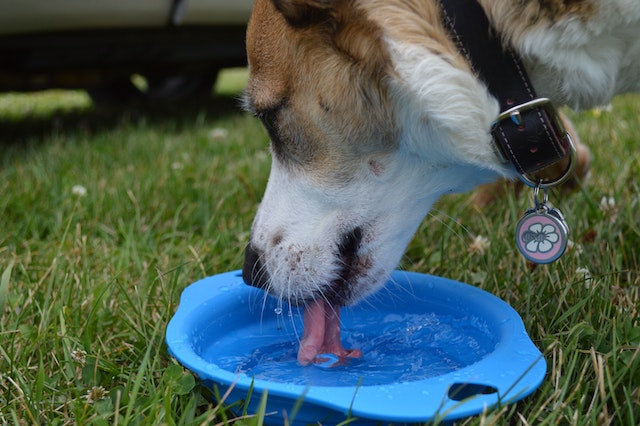What to do if your dog is not drinking water?

Water is an essential component of a dog’s body and crucial for its health. It is required for the proper functioning of all cells, organs, and tissues. Many people only realise the importance of water when faced with the negative consequences of dehydration.
“Output” refers to the amount of fluid leaving the body. Output can be normal fluid losses like drooling, panting, urination, and defecation. Output can also be due to abnormal losses such as diarrhoea, vomiting, or bleeding. It’s worth mentioning that even losing just 10% of the body’s water content can be fatal.
How Much Water Should Dogs Drink?
In a normal environment, a dog’s daily water intake depends on its size. Generally, dogs should drink about 20 to 40 millilitres of water per pound of body weight per day. So, for a 20-pound dog, that’s roughly 3 to 4 cups of water, and for a 40-pound dog, it’s 6 to 8 cups per day.
Occasionally, some dogs may drink too much water, which can also lead to problems like water intoxication.
Factors Affecting How Much Water Dogs Should Drink
Several factors can affect the amount of water a dog needs. For instance, recent medications (such as steroids), vigorous exercise, constant exposure to high temperatures, and consumption of high-sodium treats or primarily dry kibble can all increase a dog’s water intake.
Reasons Why Dogs Might Drink Less Water
There are various reasons why a dog might drink less water. Just like with humans, some dogs naturally prefer drinking less than others, but the concerning scenario is when a dog suddenly stops drinking water. If your dog suddenly stops or significantly reduces water intake, it’s crucial to pay close attention to the issue and promptly contact a veterinarian if problems arise.
In general, some reasons why dogs might drink less water include:
- Diet. Dogs that eat canned food (which has more water content than dry kibble) typically drink less water.
- Lifestyle. Dogs with a sedentary lifestyle might drink less than active dogs (since exercise leads to faster fluid loss).
- Environmental factors. Some dogs might drink less as seasons change and temperatures drop.
- Anxiety and stress. Some dogs might not drink water in new environments or under special circumstances due to heightened anxiety caused by environmental changes.
- Illness factors. Any illness that causes discomfort can reduce a dog’s water intake. This might include viral or bacterial infections, pain, gastrointestinal issues, cancer, kidney disease or failure, bladder infections, etc. Anything that makes a dog feel unwell can lead to decreased appetite and water intake.
Symptoms of Dehydration in Dogs Signs of dehydration can be subtle and include:
- Lethargy
- Dry gums
- Increased heart rate
- Sleepiness
- Loss of skin elasticity
- Prolonged capillary refill time
- Sunken eyes
- Weakness
What to Do If Your Dog Drinks Less Water?
If your dog’s water consumption suddenly decreases, evaluate all aspects of your dog’s behaviour, such as:
- Is it eating normally?
- Is its bowel movement normal? Is there diarrhea?
- Is your dog urinating normally?
- Is your dog licking its lips or drooling excessively?
- Is there vomiting?
- Is your dog coughing? Do you notice difficulty breathing?
- Does your dog appear painful? Is it limping? Does it have a hunched posture?
- Can you see any wounds on your dog’s body?
- Is your dog’s activity level the same as before? Is it playing at the door or greeting you as usual? Or is it lethargic and less active?
Any abnormality in your dog should be taken seriously. If your dog is very young or old, pregnant, or has medical issues like diabetes or kidney disease, it could worsen the severity of the problem.
How to Encourage Your Dog to Drink Water
If your dog is drinking less water, you can try the following methods to encourage it to drink:
- Thoroughly clean its bowl and refill it with fresh water.
- Some dogs enjoy pet fountains. You can make a small homemade fountain to attract your dog to drink.
- Let your pet lick water from your hand or fingers.
- Provide wet food, as it has much higher water content than dry kibble.
- Mix warm water or low-sodium broth into your dog’s food. Adding it 30 minutes before feeding may be more effective.
- If your vet approves, you can provide your dog with a small amount of water supplement.
- Placing an ice cube in the water bowl can encourage some dogs to drink.
- If you have any concerns about your dog’s water intake, promptly contact a veterinarian.
- Offer bottled or filtered water to your dog. Some dogs prefer the taste of this water and may drink more.
- Finally, you can use a syringe to give water to your dog. Generally, if your dog is seriously ill, administering fluids with a syringe can be beneficial. When syringe-feeding water, gently administer it to the front of your dog’s mouth or cheek pouch, avoiding direct injection into the throat to reduce the risk of aspiration or choking.
